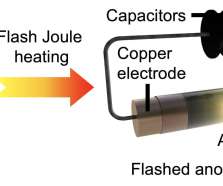Rice team uses deep eutectic solvent to leach cobalt, lithium from spent Li-ion batteries
Green Car Congress
APRIL 2, 2019
The Rice University lab of materials scientist Pulickel Ajayan has used an environmentally friendly deep eutectic solvent to extract valuable elements from the metal oxides commonly used as cathodes in lithium-ion batteries. As a whole, recycling lithium-ion batteries is typically expensive and a risk to workers. Tran et al.




















Let's personalize your content